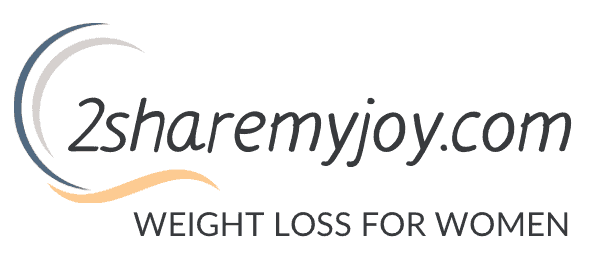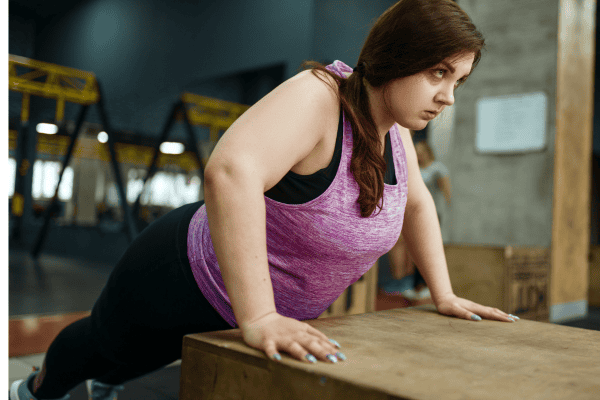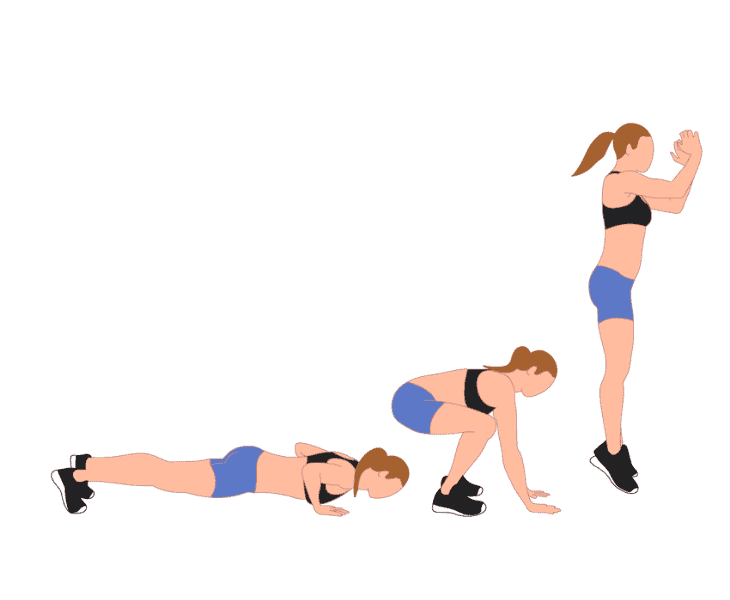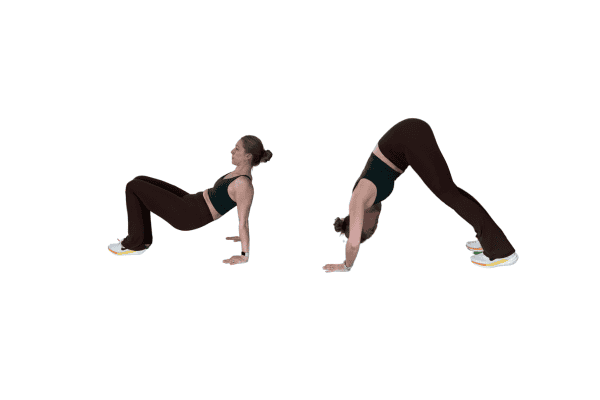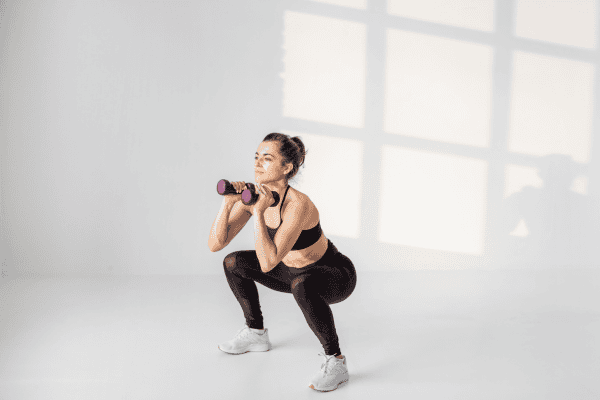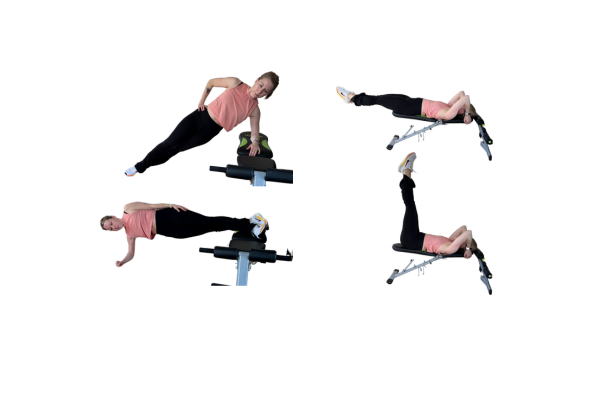Resistance Band Core Workout
This resistance band core workout isn’t just about sculpting a strong, toned core; it’s a testament to the adaptability and efficiency of resistance band exercises for core strengthening.
What’s remarkable about these exercises is their ability to seamlessly integrate into your at-home routine, making it easier than ever to commit to your fitness journey.
Whether you’re just starting or looking to add variety to your workouts, resistance band core exercises for beginners provide a solid foundation. They even compare to tradition resistance training when you look at strength gains (source).
More Resistance Band Workouts:
- Resistance Band Leg Workout
- Resistance Band Glute Workout
- Resistance Band Back Workout
- Resistance Band Arm Workout
9 Resistance Band Exercises for the Core
#1 Resistance Band Core Twist
Let’s kickstart this adventure with the Resistance Band Core Twist, a foundational exercise that’s perfect for beginners yet effective enough for those more advanced.
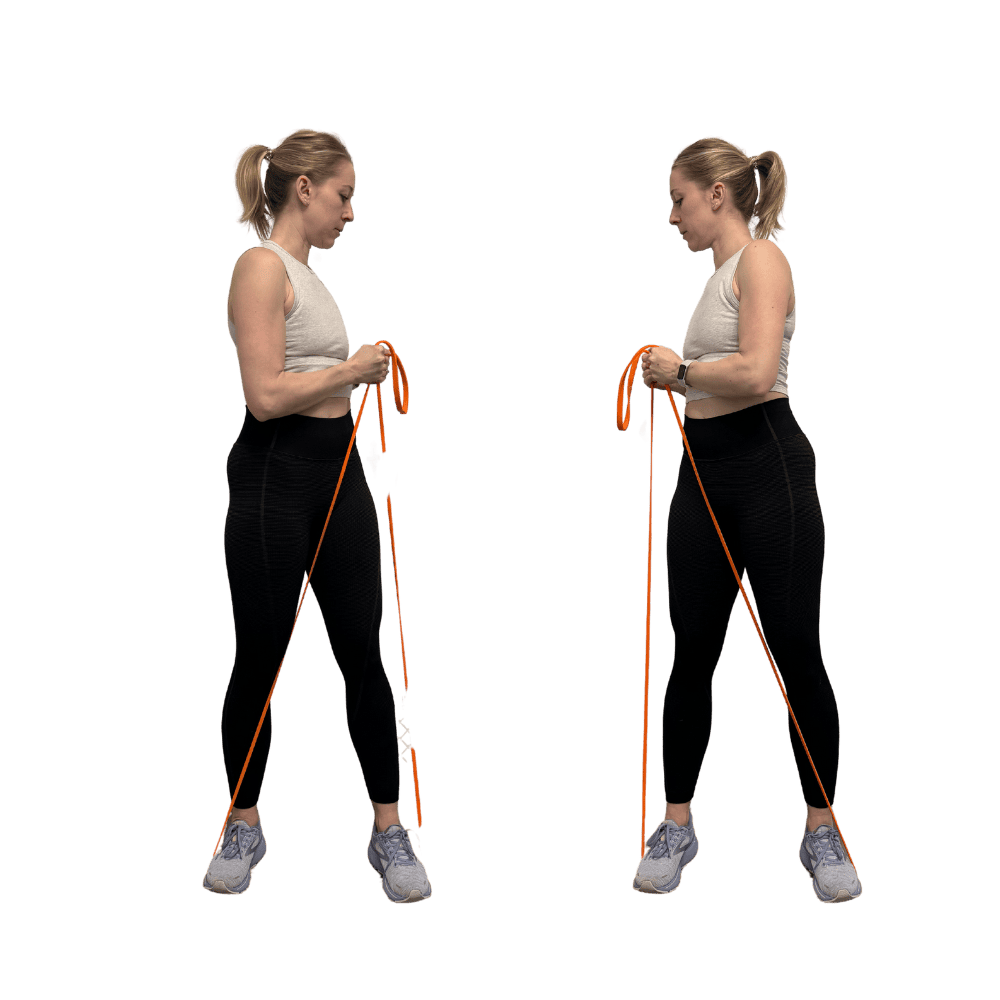
- To start, stand with feet shoulder-width apart, firmly anchor the middle of the band under your feet, and grasp the ends with both hands.
- Keep your arms extended in front of you at chest level.
- Now, embrace the core engagement as you rotate your torso to the right, stretching the band with control, then smoothly to the left.
- This rhythmic, side-to-side motion not only targets the broad spectrum of your core muscles but places a spotlight on those often hard-to-reach obliques.
#2 Resistance Band Side Bend
The resistance band side bend invites you to do just that, primarily targeting the lateral muscles of your abdomen – the ones responsible for the coveted hourglass figure.
Here’s how you can add this effective move to your resistance band core workout at home.
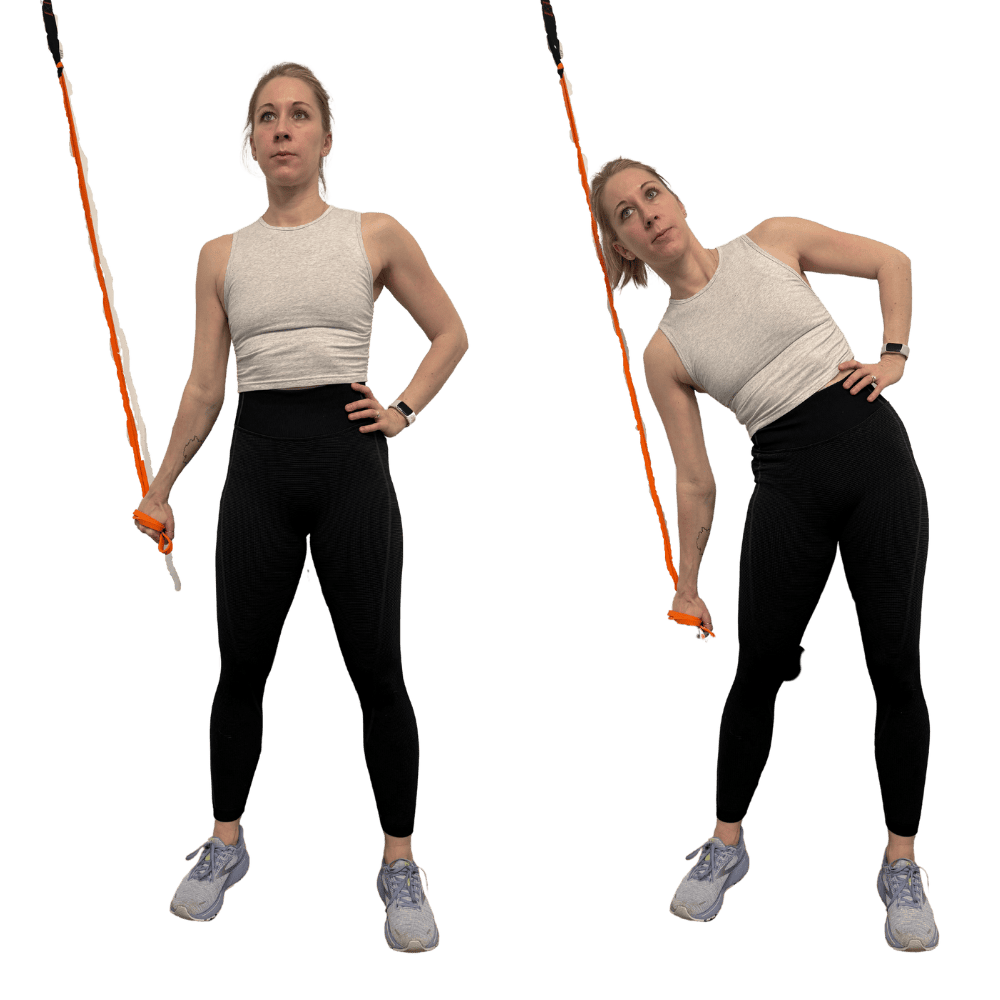
- Stand with your feet hip-width apart, loop one end of the band under your left foot, and hold the other end with your left hand. You can also anchor it on the top of a door.
- Keeping your back straight and core engaged, lean to your left, feeling a deep stretch on your side. Then pull back to starting position.
- This simple yet powerful exercise trains your obliques, contributing significantly to a slimmer waistline, making it a must-try for resistance band core exercises for beginners.
#3 Resistance Band Reverse Crunch
With the resistance band reverse crunch, you embark on a journey to sculpt your lower abs, a zone many of us find challenging to tone.
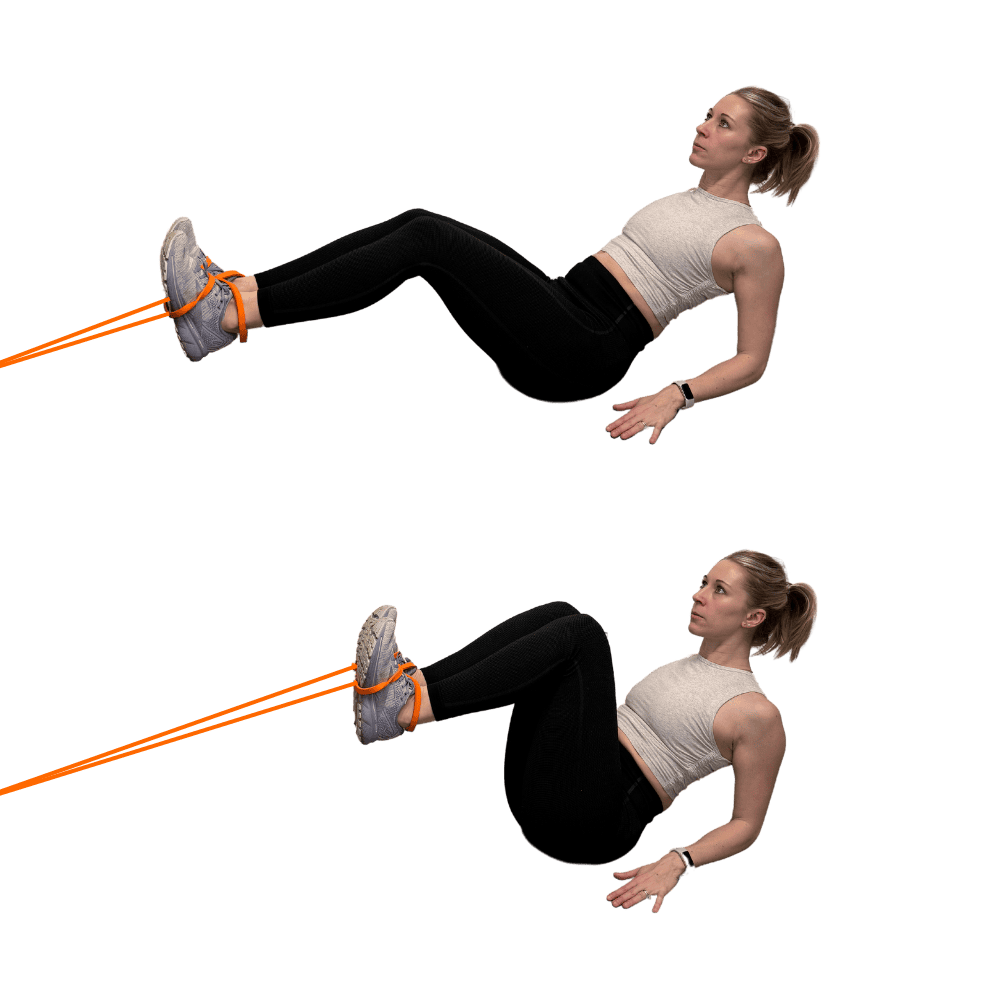
- Attach the resistance band at the bottom anchor or door. Start by lying flat on your back, knees bent, and feet on the ground. You can also lift them straight off the floor for a challenge.
- Securely loop the other end of the resistance band around your feet.
- Gently raise your knees towards your chest, keeping the band taut, and then slowly return to the starting position.
- What makes the resistance band core exercises for beginners like the reverse crunch so compelling is their inherent simplicity yet profound impact on the core, particularly the elusive lower abs.
#4 Resistance Band Crunch
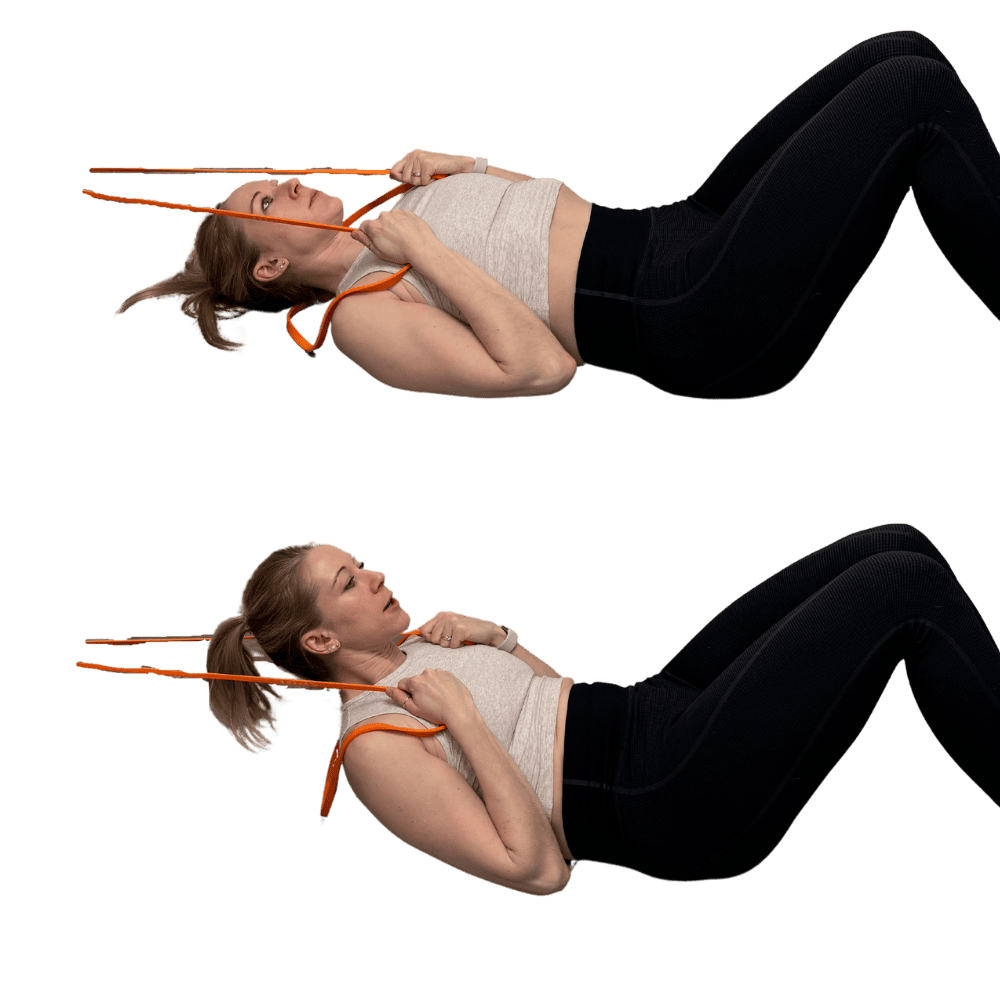
If you’ve been pondering the question, “Can resistance band core exercises truly revamp my workout routine?“, allow me to introduce you to the resistance band crunch. This move seamlessly blends the traditional crunch with the dynamic resistance of a band, creating an amplified core challenge. Here’s how you do it:
- Anchor the resistance band low and lay flat on the floor. Hold the other end of the resistance band with both hands at your shoulders and press your elbows on the sides of your body.
- Make sure there is tension on the resistance band, engage your core, then start to crunch. Lift your shoulders off the floor as if you want to touch the ceiling with your nose.
- Keep lower back on the floor. Return to starting position and repeat as desired.
A resistance band core workout at home not only makes your exercises more challenging but also ensures you’re actively strengthening your core with every rep. Transform your routine with this simple addition, and witness the strength return to your core.
#5 Resistance Band Seated Core Twist
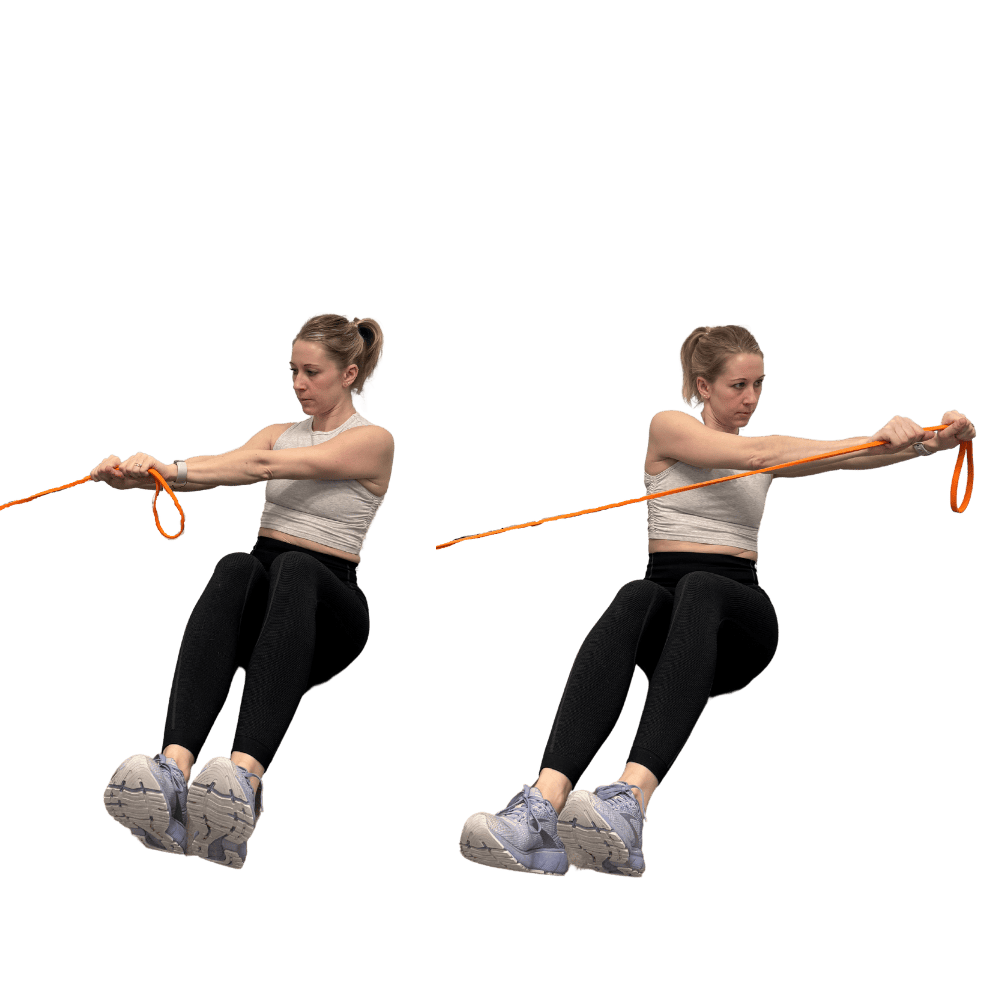
The resistance band seated core twist becomes your ally in sculpting a stronger, more defined core. Here’s how you do it:
- Securely anchor your resistance band at a low point, sit on the ground with your legs slightly bent, and grasp the band with both hands.
- Keeping your back straight, rotate your torso to the side (away from anchor) as far as you can, engaging those obliques.
- Then, return to the center and repeat on the other side.
The seated core twist strengthens your core, which is crucial for overall stability and injury prevention.
Plus, it’s a fantastic addition to any resistance band core workout for beginners, bringing you one step closer to your fitness goals without stepping out the door.
#6 Resistance Band Wood Chop
Imagine channeling the power and precision of a woodsman into your core workout–that’s what you do with the resistance band wood chop.
This exercise takes you through a dynamic, full-body movement that not only puts your core to work but also engages your shoulders, arms, and legs. It’s like you’re chopping wood, but instead of an axe, you have a resistance band.
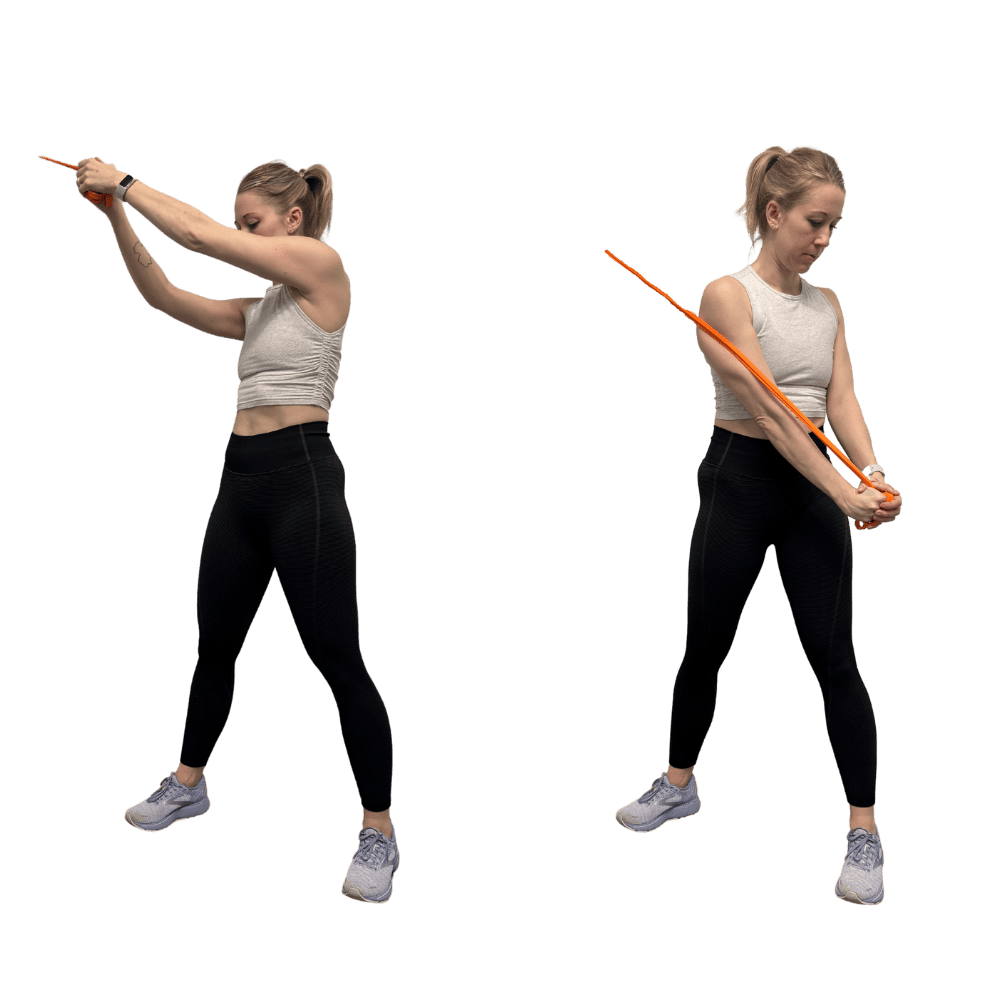
The beauty of this movement lies in its ability to mimic day-to-day activities, training your core for real-life motion and enhancing its responsiveness.
As you perform the resistance band wood chop, you’re not just working on toned abs; you’re building a core that’s adept and strong, ready to support you in every other physical activity you undertake.
So grab your resistance band, and let’s sculpt your core, strengthening it from every angle with the transformative power of the wood chop:
- Anchor the resistance band above your head (top door), stand sideways to the anchor and hold the resistance band with tension above your head to the side closer to the anchor.
- Now “chop the wood” by pulling the band across your body diagonally downwards to your hips on the opposite side. Keep your arms slightly bent and core engaged.
- Return to starting position and repeat.
#7 Resistance Band Side Plank and Pull
This resistance band side plank and pull isn’t just any workout; it’s a powerhouse for your obliques and core, delivering an intensity that’s both challenging and rewarding.
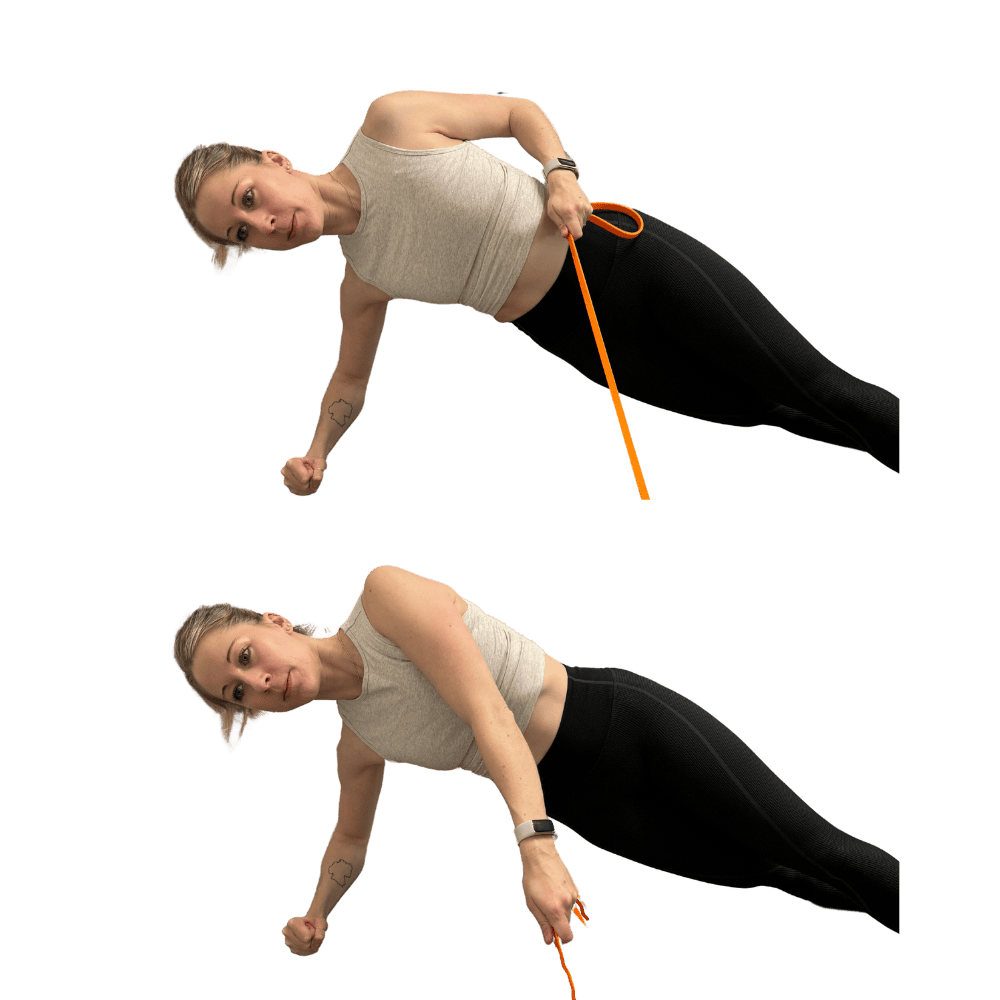
- Place yourself in a side plank position, the resistance band anchored securely on a low anchor in front of you. The other end held in your top hand.
- As you hold your body in a straight line, you pull the band towards you, elbow close to your side, feeling the resistance intensify the workout on your core and especially your obliques.
This dual-action exercise doesn’t just promise a stronger core; it delivers one, making it a perfect addition to your resistance band core workout at home. It’s a testament to the power of resistance bands in sculpting your core, proving that with the right exercises, achieving a toned and strong midsection is completely within reach, especially for beginners.
#8 Resistance Band Dead Bug
One standout move in the resistance band core workout at home is the Resistance Band Dead Bug.
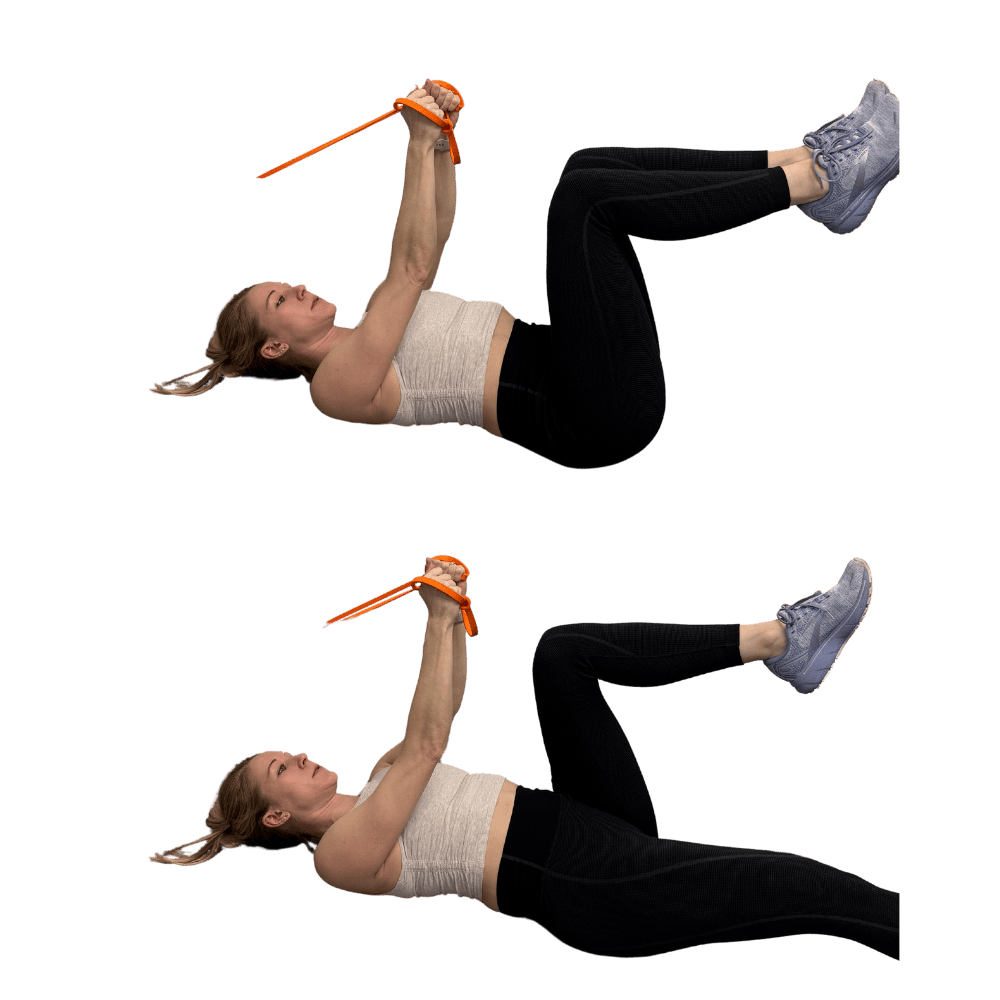
It’s an adaptation that takes the classic floor exercise to new heights, emphasizing deep core engagement and stability enhancement. Here’s how you do it:
- Lie on your back, arms extended toward the ceiling, holding the ends of the resistance band, with the band anchored behind your head at a ow anchor point.
- Keep your arms straight up and tension on the band. Your knees are bent and feet off the floor. Your hips should be at a 90 degree angle.
- Now stretch one leg out and lower it to the floor but don’t touch the floor. Then bring it back to starting position.
- Make sure to keep the core engaged. Alternate legs.
#9 Resistance Band Paloff Press
Have you ever tried the Resistance Band Paloff Press? This exercise is a game-changer when it comes to resistance band exercises for core. It may sound complex but believe me, its beauty lies in its simplicity.
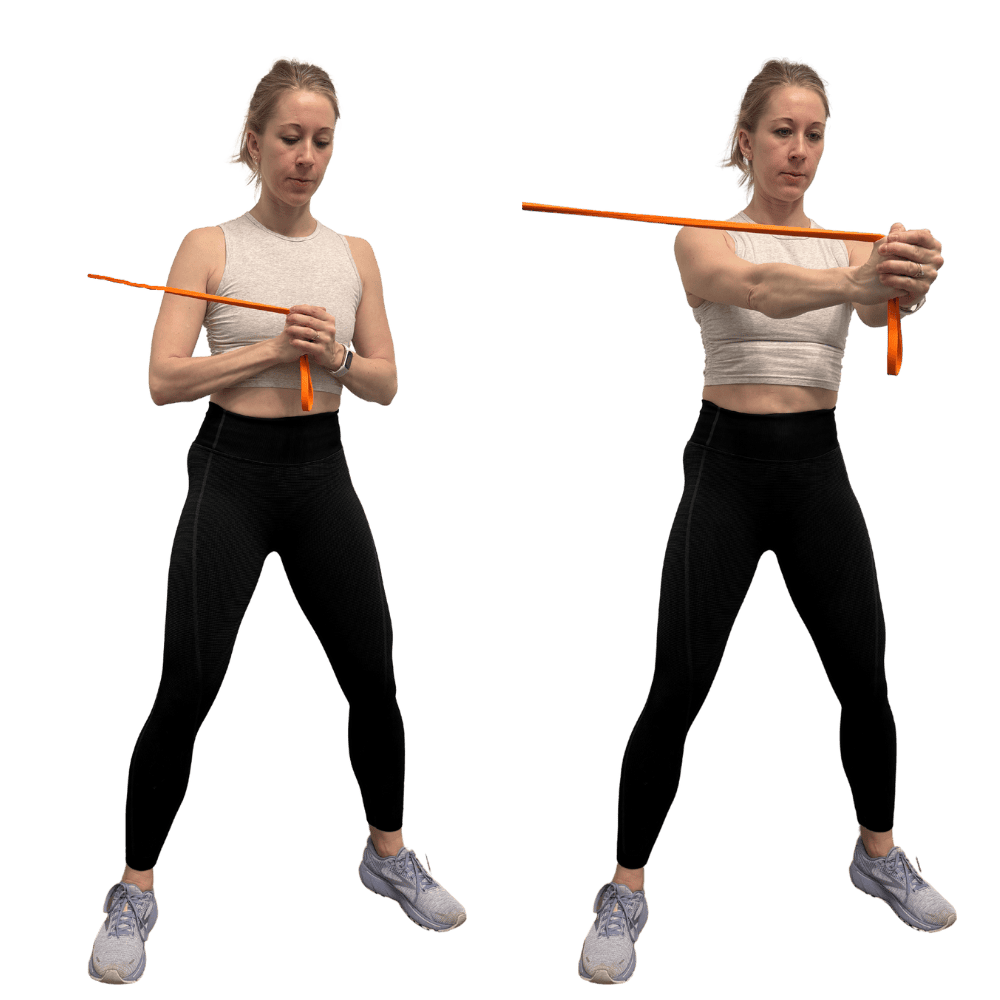
This isn’t just any routine movement; it’s an anti-rotational exercise that requires every bit of your core to stabilize, ensuring not a single inch of movement aside from your arms extending.
The Paloff Press is a cornerstone in the resistance band core workout for beginners and seasoned athletes alike because it targets the deep core muscles, reinforcing your midsection’s stability and strength.
Adding this to your resistance band core workout at home can significantly enhance your core’s resilience and your overall balance. Embrace the challenge and the results will surely follow.
- Anchor the band chest high. Stand with your shoulders facing the anchor. Feet high widths apart.
- Hold the end of the band with both hands in front of your chest and put tension on the band.
- Now press the band away from your chest and engage the core. Then move it slowly back and repeat. Keep your core engaged the entire time.
Can You Tone Your Stomach with Resistance Bands?
Have you ever pondered the question, can you tone your stomach with resistance bands? The answer is a resounding yes, and I’m here to tell you why. Resistance bands are not just versatile; they’re a powerhouse when it comes to enhancing core workouts.
Especially for beginners, engaging in a resistance band core workout at home can create significant changes. Imagine each stretch, pull, and twist with the band not just as movements, but as steps towards achieving a more defined and toned core.
Even when confined to your living room, these exercises promise results, turning your home into a personal gym. All it requires is persistence and the right set of resistance band core workout at home routines.
The key is to select a resistance band thickness that is challenging. Even advanced athletes can benefit from these exercises. To tone your stomach with resistance bands follow these steps:
- Do 8-12 repetitions and 3 sets of each exercise
- Select a resistance band strength that you are close to or at failure at the last rep.
- Increase your reps each week. If you get beyond 12-15, try the next resistance band strength (progressive overload).
Core Muscles Anatomy
When we talk about resistance band core workout at home, we’re diving deep into the heart of our physical fitness.
The core muscles, including the abdominals, obliques, and lower back muscles, serve as the central link between your upper and lower body.
Strengthening these muscles is a game-changer, not just for a toned stomach, but for enhancing your overall physical stability and preventing injuries.
Whether you’re a beginner or diving into more advanced resistance band core exercises for beginners, understanding the anatomy of these muscles illuminates the reason behind each twist, bend, and crunch.
They are the foundation that supports every other movement your body makes. From standing up straight, bending over to tie your shoe, to performing an impressive resistance band core workout for beginners, every motion originates from or moves through the core.
First up, we’ve got the transverse abdominis, the deepest layer of your core. This muscle is like the backbone of your spine, providing essential support and stability.
This ab muscle plays a critical role in prevention and treatment of low back pain.
It wraps around your spine, keeping everything in place. When you brace your core, you activate this muscle, ensuring spine stability. Bracing exercises would be paloff press, planks, etc.
Moving on to the internal oblique, it’s situated just above the transverse abdominis and beneath the external oblique.
This muscle helps you bend forward and twist sideways. While it might not be visible from the outside, it’s essential for rotational and bending movements (Side bends or core twist)
Now, let’s talk about the external oblique, which sits atop the internal oblique and below the rectus abdominis.
While exercises targeting the external obliques also engage the internal obliques, specific movements like cable woodchoppers really hit them efficiently.
Last but not least, we’ve got the rectus abdominis, which is the more visible muscle, giving you the six pack look. These bad boys are all about stability and flexion, helping you bend forward, lift your hips, and stabilize your movements. You can “grow them” with any crunching type exercise.
How Do Resistance Bands Help with Belly Fat?
You might be wondering how a simple resistance band could possibly help you lose that stubborn belly fat. Resistance bands can be a valuable tool in your arsenal for targeting belly fat and overall body fat reduction. Here’s how they can help:
- Muscle Activation: Resistance bands engage your core muscles effectively during exercises. When you perform movements such as banded squats, lunges, or twists, your abdominal muscles, including the rectus abdominis and obliques, work hard to stabilize your body. This increased muscle activation can contribute to strengthening and toning your abdominal muscles.
- Calorie Burn: Resistance band exercises are often dynamic and involve multiple muscle groups, which can increase your heart rate and calorie expenditure. When you perform high-intensity resistance band workouts, you’re burning calories not only during the workout but also during the recovery period as your body works to repair and build muscle.
- Metabolic Boost: Resistance training, in general, can help increase your metabolic rate. As you build lean muscle mass through resistance band exercises, your body becomes more efficient at burning calories, even at rest. This can contribute to overall fat loss, including belly fat.
- Variety and Convenience: Resistance bands offer a wide range of exercises that target different muscle groups, including the core. You can easily incorporate resistance band exercises into your routine, whether you’re at home, traveling, or at the gym. This versatility allows you to keep your workouts interesting and challenging, which can help you stay motivated and consistent in your fitness journey.
- Progressive Overload: As you get stronger, you can increase the resistance level of your bands to continue challenging your muscles. Progressive overload is essential for muscle growth and fat loss, and resistance bands provide a convenient way to adjust the intensity of your workouts as you progress.
While resistance bands can be effective for targeting belly fat when combined with a balanced diet and regular cardiovascular exercise, it’s essential to remember that spot reduction is not possible. To see significant results in reducing belly fat, it’s crucial to focus on overall fat loss through a combination of resistance training, cardiovascular exercise, and a healthy diet.
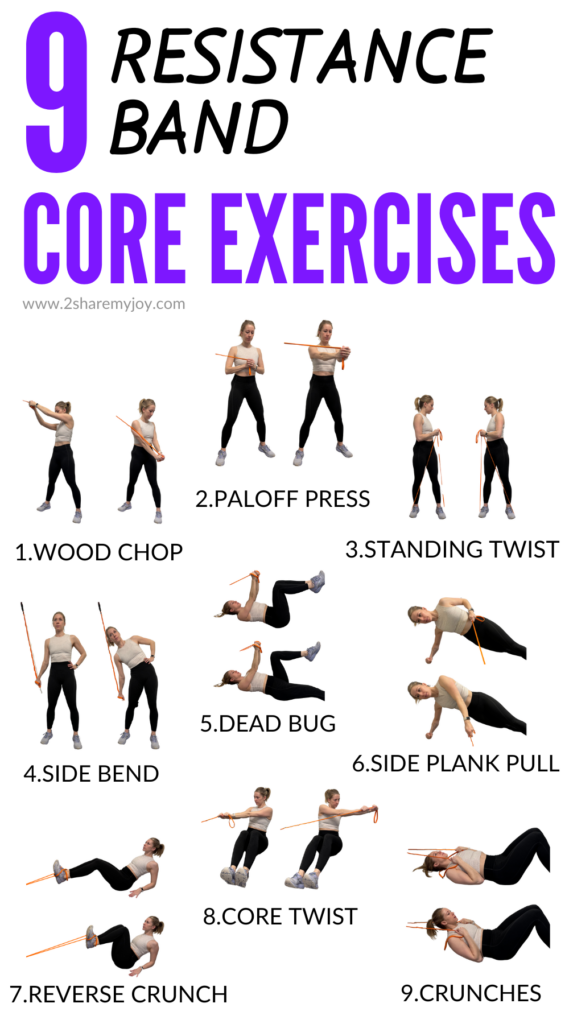
FAQ
Yes, absolutely! Resistance bands add an extra challenge to core exercises by increasing resistance. This helps to engage your core muscles more deeply than without bands. Consistency and proper form are key. Incorporating resistance band exercises for core into your routine can lead to visible toning and strength improvements over time.
Definitely. Resistance band core exercises for beginners are a gentle yet effective way to start strengthening your core. The beauty of using resistance bands is that the resistance can be adjusted according to your current fitness level. Start with lighter resistance and gradually increase as you grow stronger.
Yes, one of the great advantages of using resistance bands is their versatility and convenience, making them perfect for home workouts. With just a small space and your resistance band, you can perform a wide range of exercises targeting your core without the need for expensive or bulky equipment.
Although resistance bands can be useful in addressing belly fat alongside a balanced diet and consistent cardiovascular exercise, it’s important to understand that spot reduction isn’t feasible. Achieving noticeable reductions in belly fat necessitates concentrating on overall fat loss, which requires a blend of resistance training, cardiovascular exercise, and nutritious eating habits.
